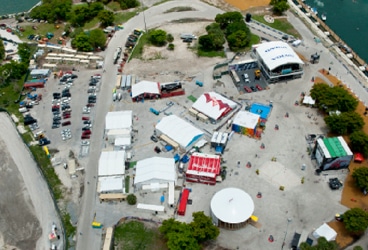
Volvo-Miami
When I entered the Downtown Miami Volvo Ocean Race Village at 5 p.m. on a Thursday afternoon in May, two days before the big In-Port Race and Leg 7 send-off, I thought I’d arrived a day late. Before me was a vast expanse of concrete encircled by elaborate sponsor pavilions, but experienced by hardly a soul.
I entered deeper into the Village (see photo), past vacant booths selling race merchandise, water, and sunblock. Music blared from speaker towers on an empty stage, and workers wielding shovels shaped a freshly dumped pile of sand into a temporary beach volleyball court. Everywhere I went, the Village was eerily quiet, even the much-hyped PUMA rooftop bar and Social Club with cornhole decks and ping-pong tables. I thought to myself, “Where the hell is everyone?”
I wandered behind the scenes, among the containers and workshops, where I stumbled into PUMA Ocean Racing‘s skipper and SW columnist Ken Read. “Yup, it’s pretty dead,” he agreed when I shared my obvious observation. “Unfortunately, it’s been like this all week.”
I attributed this ghost town of a village to it being a workday, and downtown Miami being a working city. Maybe, I thought, things would change over the weekend when all the planned festivities kick in, drawing in thousands of curious Floridians and hard-core race fans. But that never happened.
Attendance figures for the first weekend, when the fleet arrived, were rumored to be 3,000 “through the gate.” Attendance could have doubled, or even tripled, in the second weekend, but I saw more armies of sponsors and V.I.P. guests than fans, sailors, and passersby. The boats came and went, and local organizers did their best with what they had, but ultimately, no one really showed up.
So was the Volvo Ocean Race’s only North American stopover a total bust? Yes. And no. In its current model, the stopover component of the race (i.e., the Village) is primarily about fulfilling the business-to-business agendas of teams and race sponsors. Miami is an excellent venue for schmoozing, so to that end, it may have been a hit. For the spectator, however, it was a big miss, and that was in large part because of the location and the design of the Village itself. Having exclusive pavilions as the focal points detracted from the most important visual ingredients: the sailors, the boats, and the action. Here’s what I’d like to see next time:
The In-Port race and the restart must be visible from the Village. The Boston stopover in the race’s previous edition was excellent. When the boats left the dock, people stayed to watch and listen to the live commentary, sticking around for the after party. In Miami, there was no reason to stay after the boats left.
Put the teams and the sailors front and center. The shore bases, as ugly as they may be, were hidden and inaccessible to the public. This is pit row, where the guys are fixing sails, packing meal bags, splicing, and hanging out. The compounds should be better integrated with the Village, not put out of sight.
Let us touch the boats. In Miami, the boats were tied to the dock, some 40 feet away from the bulkhead viewing area. Security guards at the gangplanks denied access, forcing visitors to gawk from the seawall. We need to see them up close, ask questions, and be part of an experience we can’t get on the Internet.
Dave Reed
editor@sailingworld.com
To read more about the Volvo Ocean Race, click here.
To read more Editor’s Letters from Dave Reed, click here.









